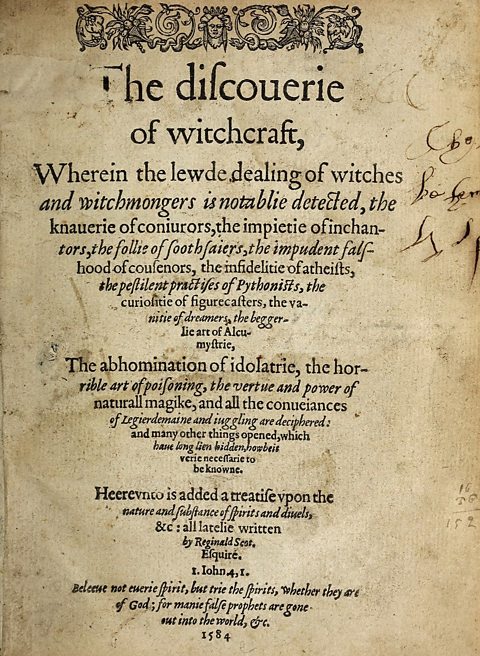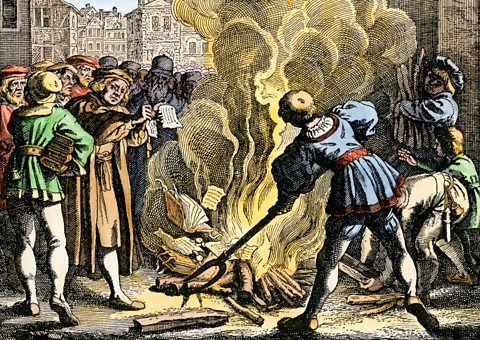The end of witch trials
During the 1700s, the witch trials died out across Europe.
By the time this happened, though, thousands of Scots had been found guilty of witchcraft and had been executed.
So why did the witch hunts end?
Changes in beliefs
 Image source, ALAMY
Image source, ALAMYIn the 17th and 18th Century, European nations stopped executing people for witchcraft:
- the Dutch Republic saw the last execution of a witch in 1609
- the last execution in England was in 1684
- the last execution in mainland Europe is thought to have occurred in Poland in 1793
In 1727, Janet Horne, a woman from Dornoch, Sutherland, became the last person executed for witchcraft in Scotland.
There had always been objections to witch hunts across Europe:
- some argued that witchcraft was not real
- some said witches who confessed were confused or deluded
- there was seen to be a lack of real evidence against the accused
- there were moral objections to the cruel treatment of suspects
- people doubted witchfinders and suspected some of fraud
Over time, doubts about witch hunts grew and the number of trials across Europe fell. This may be because profound changes were taking place in European society.
 Image source, ALAMY
Image source, ALAMYReligious change
 Image source, ALAMY
Image source, ALAMYDuring the 1500s the ReformationReligious revolution of the 16th Century which questioned the teachings and authority of the Catholic Church and led to the development of Protestant Christianity. resulted in great religious upheaval. New Protestant beliefs were at odds with Catholic teaching. Religious arguments led to struggles for power in local areas, in different countries, and between countries.
Large scale wars were fought by Protestant and Catholic nations resulting in the deaths of millions of people.
Within Protestant and Catholic nations, believers in the rival faith could face persecution.
Some historians believe that the religious turmoil of the Reformation contributed to the witch hunts as leaders of the different religions tried to demonstrate that they were fighting against evil.
 Image source, ALAMY
Image source, ALAMY Image source, ALAMY
Image source, ALAMYEventually, peace returned and the right to follow different Christian faiths was agreed. Some historians argue that witch hunts became less common as a result.
The Enlightenment
 Image source, ALAMY
Image source, ALAMYAn intellectual movement called the Enlightenment swept through Europe in the 17th and 18th century.
People were encouraged to use science to understand the world around them.
This had an impact on how people viewed things they that struggled to understand.
Rather than assume that mysterious happenings, such as the failure of a harvest, or an unexplained death, were the work of witches or the Devil, people were encouraged to look for more natural rather than supernatural causes.
This type of more educated thinking eventually spread down from the kings and lords, down to the local priests, and then to the working people.
 Image source, ALAMY
Image source, ALAMYChanges in society
Over time, Scottish people became shocked by high profile witch hunts that had led to large numbers of deaths.
In particular, the ‘Great Scottish Witch Hunt’ of 1661-2 had seen at least 660 people named as witches with over a hundred deaths. This was alarming to people at the time, and cause them to question the trials.
The Great Scottish Witch Hunt, 1661-62
 Image source, ALAMY
Image source, ALAMYOver a 16 month period during 1661 to 1662, Scotland carried out one of the largest witch hunts ever seen in Europe.
It started as an attempt to root out suspected witches in the small towns and villages to the east of Edinburgh.
It then spread to become a nationwide hunt to rid the country of witchcraft and wickedness.
While the exact numbers are hard to confirm, it is thought that around 660 people were put on trial and over a hundred were executed.
The scale of this witch hunt caused people to question the whole process of trying people for witchcraft.
 Image source, ALAMY
Image source, ALAMYWhen did witchcraft laws change?
Legal representation
Although the Scottish Witchcraft Act of 1563 had made practising witchcraft a crime punishable by death, it did ensure that witches were tried in legal courts and were able to receive legal advice and protection.
Often those accused of witchcraft were unable to get someone to represent them, or they arrived too late.
Margaret Barclay
This lack of access to legal advice happened in the case of Margaret Barclay from Irvine. The trial was already underway by the time she was appointed a lawyer. By that point, the damage done and the trial lost. She was executed in June 1618.
Towards the end of the 1600s, though, more people had did have access to lawyers who could cast doubt on testimony or point out the lack of evidence.
Judges
The Great Witch Hunt of 1661-2 saw attitudes to witch trials changing.
Judges were becoming more sceptical about evidence, particularly confessions or accusations made under torture. There was growing suspicion of witch prickers, who were seen to accuse innocent people for their own personal gain.
As a result, the courts were clearing more people of charges.
Privy Council
 Image source, ALAMY
Image source, ALAMYThe attitude of the Privy Council was also changing. In April 1662, the council took action to prevent innocent people from being accused:
- A new rule was made that a suspected witch could only be arrested after an official warrant was issued. This made it more difficult for local communities to bring about a prosecution.
- The use of witch pricking and torture without the permission of the council was banned. This reduced the number of confessions and accusations.
- Two witch prickers, John Kincaid and John Dick were put in prison. This discouraged other witch prickers and removed their findings as a source of 'evidence' against witches.
 Image source, ALAMY
Image source, ALAMYKatherine Liddell
 Image source, ALAMY
Image source, ALAMYThe case of Katherine Liddell, an alleged witch from Prestonpans, illustrates the new attitudes.
Katherine Liddell was a widow with a reputation for having strong opinions.
In 1678, she was arrested and suspicion of witchcraft and subjected to illegal torture.
She was kept awake for days in an attempt to make her confess – a process known as waking the witch – and her body was pricked with sharp objects in an attempt to find a Devil's Mark.
Katherine refused to confess and, at her trial, she complained about the use of torture against her.
Not only was she set free, but one of her tormentors was imprisoned for abusing her.
 Image source, ALAMY
Image source, ALAMYWitchcraft Act, 1735
Across Europe, laws were introduced bringing witch hunts to an end.
In Great Britain, the Witchcraft Act, 1735 revoked all previous Witchcraft Acts and ruled that witchcraft was not a crime.
no Prosecution, Suit, or Proceeding, shall be commenced or carried on against any Person or Persons for Witchcraft, Sorcery, Inchantment, or Conjuration, or for charging another with any such Offence, in any Court whatsoever in Great Britain.
The Witchcraft Act, 1735
Instead, the Act made it a crime to pretend to perform any kind of witchcraft or fortune telling. Instead of being real magic, witchcraft was now seen as a type of fraud.
Test your knowledge
More on Scottish witch trials
Find out more by working through a topic
- count7 of 7

- count1 of 7

- count2 of 7
